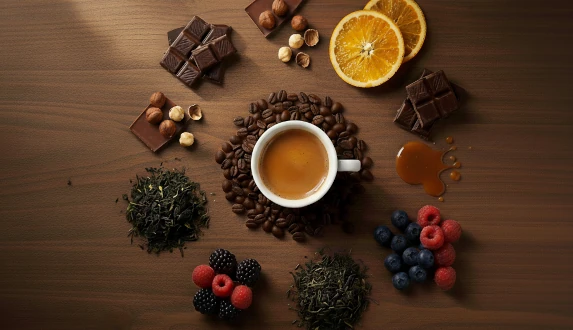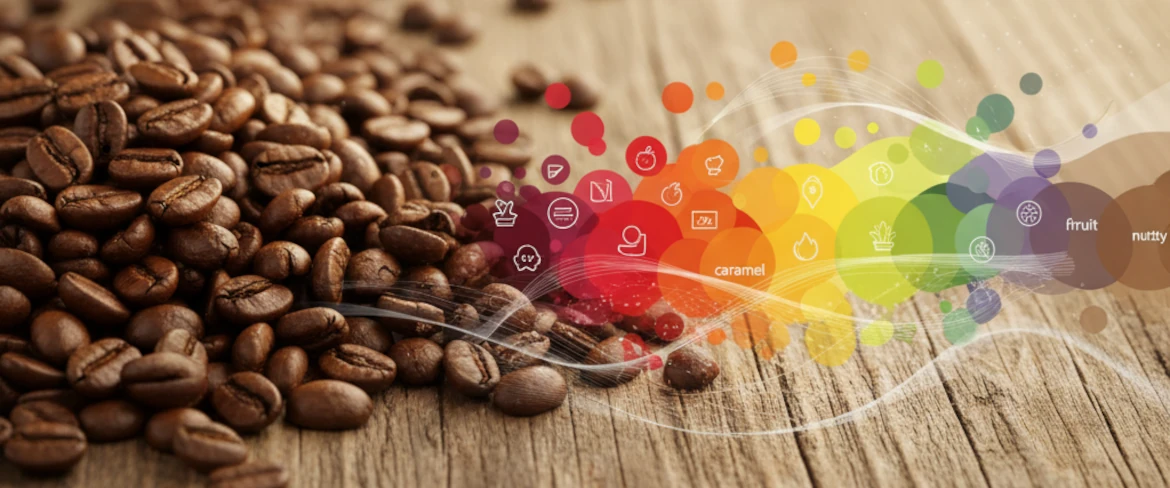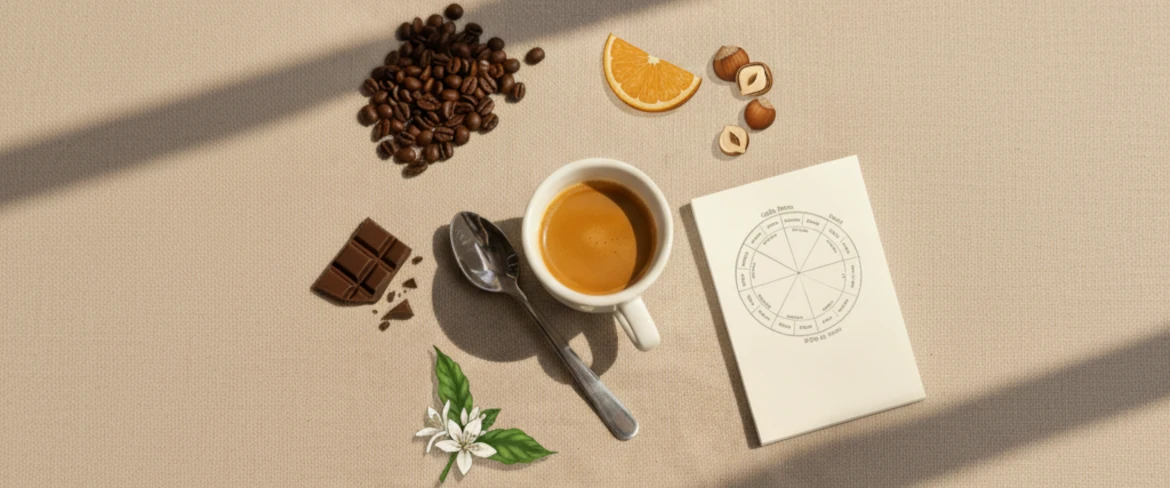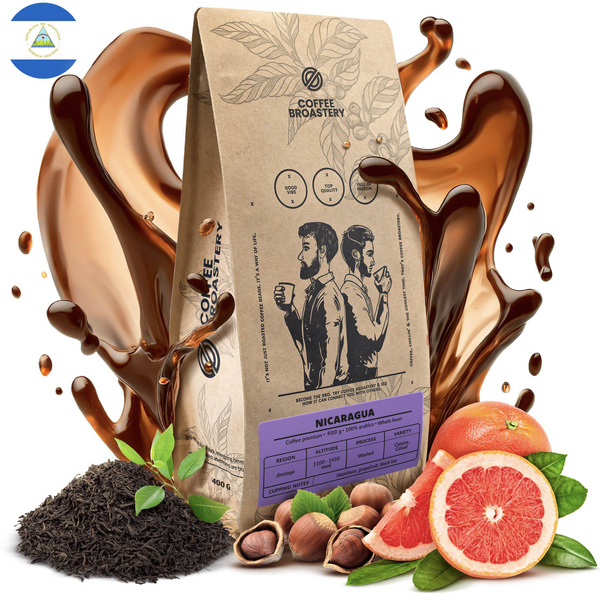The flavours of coffee – a guide to flavour notes and sensory profiles

Do you think coffee simply tastes “like coffee”? It’s time to spread your wings and explore deeper flavour sensations! Speciality coffee is a completely different world – one where various flavours of coffee meet: notes of chocolate, citrus fruit, flowers, nuts and spices. Each cup can be a unique experience – provided you learn to read what’s written on the label.
This article is your guide to the flavours of coffee – you’ll learn what a coffee flavour profile means, how to understand terms such as acidity, body and aftertaste, and why a coffee’s origin or processing method can completely change its taste and aroma. After reading, you’ll easily recognise whether your cup holds chocolate coffee, a fruity brew or one with tea-like notes.
Summary:
- Why does every coffee taste different?
- What are flavour notes in coffee?
- Acidity and body – key elements of a coffee’s profile
- The most popular flavour notes in coffee
- How to recognise coffee flavours during tasting
Why does every coffee taste different?
It used to be thought that coffee simply tasted like “coffee”. Today we know it’s one of the most complex beverages in the world – it contains over 800 aromatic compounds – that’s more than wine! That’s why every batch of chocolate coffee beans has its own unique flavour notes in coffee, which people in the speciality coffee industry describe as a coffee flavour profile. Depending on the bean’s origin, how it’s processed and roasted, your cup may present a chocolate flavoured coffee, a delicately fruity one, or a brew reminiscent of black tea.
Coffee origin and taste
Every region of the world has its own coffee personality – the result of climate, soil and altitude. Just as grapes take on character from where they grow, coffee origin and flavour are inseparably linked.
- Africa (Ethiopia, Kenya, Rwanda) – coffees from here often have high coffee acidity. What does it mean in practice? Freshness, liveliness and notes of citrus fruit, blackcurrant, apricot or jasmine. If you like coffees that resemble lemon juice or an aromatic fruit infusion, look for African origins.
- South America (Colombia, Brazil, Peru) – the realm of chocolatey and nutty flavours of coffee. These are smooth, sweet coffees with low acidity and a well-pronounced coffee body. Perfect for espresso and milk-based drinks.
- Asia (Indonesia, Papua New Guinea, India) – here you’ll often find a heavier body in coffee and earthy, spicy aromas. Their profiles reveal hints of spices, tobacco and cocoa – ideal for those who love depth and intensity.
💡 Did you know? Altitude directly influences a coffee’s flavour profile. The higher the coffee grows, the slower its fruit ripens – resulting in a more complex and intense taste. That’s why high-altitude coffees (for instance from Ethiopia or Colombia) have such rich flavour notes in coffee.
The effect of processing on flavour notes
What happens to the bean after harvest shapes some of its most distinctive characteristics. There are three main processing methods – natural, honey and washed – each leaving a strong imprint on the final coffee cup. Understanding processing is key to grasping why one chocolate flavoured coffee tastes sweet and velvety while another is bright and fruity.
| Processing Method | Characteristics | Flavour in the Cup |
|---|---|---|
| Natural (dry process) | Coffee cherries are dried whole, with the fruit pulp still around the bean. | Sweeter, richer aroma; often a chocolate coffee with fruity undertones. |
| Honey (semi-dry) | Part of the mucilage remains on the bean during drying. | Balanced flavour profile; caramel and nutty flavour notes in coffee. |
| Washed (wet process) | Mucilage is removed and beans are fermented in water. | Clean, crisp taste with higher coffee acidity, typical of Ethiopia or Kenya. |
Processing is one of those invisible but essential steps that make even two coffees from the same region taste completely different. Chocolate coffee beans or chocolate flavoured coffee beans often come from regions and methods that enhance natural sweetness and lower acidity.
In the next section, we’ll look at how to identify coffee flavours during tasting and what exactly terms such as coffee acidity and coffee body mean. It’s the kind of knowledge that changes the way you look at every cup!

What are flavour notes in coffee?
During coffee tasting, experts often use terms like “chocolate coffee”, “fruity”, or “floral”. Contrary to what some may think, this doesn’t mean that cocoa, fruit or flavourings were added to the coffee. These are natural flavour notes in coffee created by complex biological, chemical and thermal processes that occur during growing, processing and roasting the beans.
You could say that coffee – just like wine – has its own flavour profile. This profile is shaped by factors such as a coffee’s origin, climate, soil, altitude, processing method and degree of roast. That’s why coffee from Ethiopia can be light, with jasmine and citrus notes, while Brazilian coffee is smooth, with nutty and chocolate tones. Each cup tells a different story, encoded in its taste.
If you’d like to explore how diverse the flavours of coffee can be, visit our store category “Coffee flavour notes” – where you’ll find coffees grouped by dominant aromas: from citrus and floral to dessert-like and chocolate flavoured coffee.
💡 Did you know? During tasting, professional cuppers use a Coffee Flavour Wheel. This visual tool, developed by the Specialty Coffee Association, helps identify and understand hundreds of different flavour notes – from dried apricot to dark chocolate and caramel.
How does a coffee’s flavour profile develop?
A coffee’s flavour profile is like its fingerprint. It’s determined by the entire journey a bean takes from farm to cup. Though every bean comes from the coffee cherry, the final flavour depends on many factors – all of which give coffee its individuality.
- 🌱 Botanical variety – the bean’s genetics influence its natural flavour potential. Arabica is known for its delicate, floral and fruity tones with pleasant coffee acidity, while Robusta tends to be intense, earthy, with a heavier coffee body and more caffeine.
- 🌦️ Climate and soil – volcanic soil in Central America produces coffees full of sweetness and balance, whereas the soils of East Africa favour bright, citrusy and expressive cups.
- 🔥 Roasting – plays a key part in how a coffee tastes. Light roasting emphasises coffee acidity and floral or fruity notes. Medium roasting balances acidity and sweetness. Dark roasting enhances chocolate coffee beans flavours inspired by cocoa, caramel and toasted nuts, resulting in rich chocolate coffee experiences.
These factors – from genetics to the roaster’s craft – ensure that no two coffees ever taste the same. Each one is the outcome of a finely tuned symphony between nature and human precision.
The impact of brewing methods
The way you brew your coffee can completely transform its taste. Even the same chocolate flavoured coffee beans can taste different depending on the brewing method. Why? Because different techniques extract flavour compounds in different ways.
- ✔️ Espresso – intense and concentrated, with a rich, full coffee body. It highlights deep flavour notes in coffee such as chocolate and nuts – perfect for classic coffee lovers.
- ✔️ Drip (e.g. V60, Chemex) – brings out clarity and smoothness. An excellent way to highlight fruitiness and the bright coffee acidity.
- ✔️ Aeropress – incredibly versatile! Depending on brew time and temperature, you can achieve a refreshing, light, or creamy, mellow cup.
- ✔️ French Press – a rich, oily brew with a pronounced body in coffee; a great method to showcase deep flavours of coffee like dark chocolate.
Experiment with brewing methods the way a sommelier adjusts wine service – temperature, vessel or style. This way you’ll uncover new dimensions of your favourite beans. That’s the magic of speciality coffee: every variable – from origin to roast and brew – truly matters.

Acidity and body – key elements of a coffee’s profile
When we talk about a coffee flavour profile, two concepts appear constantly – acidity and body. These two define a coffee’s character, determining whether it’s fresh and lively or creamy and heavy. Understanding them is an important step towards consciously choosing coffees that suit your individual taste.
High-quality speciality coffee is more than just an energising drink – it’s a fascinating composition of flavours, where every element matters, from the plantation to your cup. Therefore, it’s worth learning what it actually means for a coffee to have “high acidity” or a “full body”.
Acidity in coffee – what does it mean?
Coffee acidity is a term that means something completely different from sourness. Acidity is a desirable trait – it’s what gives coffee freshness, vibrancy and complexity. Thanks to it, coffee takes on depth and brightness, becoming multidimensional and exciting for the palate. Without it, every cup would taste flat and dull.
High acidity in coffee can be felt as a pleasant, tingling sensation on the tongue – similar to the taste of a juicy fruit. Acidity gives coffee life and energy and brings out fruity flavour notes such as citrus, raspberry, blackcurrant or apple. This is why African coffees – especially those from Ethiopia and Kenya – are often praised for their bright, fruity character.
Positive acidity vs. sourness
Many beginners confuse these two concepts – yet the difference between them is substantial. Positive acidity is harmonious and pleasant, while sourness is the result of brewing mistakes or poor bean quality.
- ✔️ Positive acidity – brings lightness, brightness and a juicy freshness to the coffee. Examples: Ethiopia Yirgacheffe, Kenya AA, Colombia.
- ❌ Sourness – an unpleasant, sharp taste reminiscent of unripe lemon or vinegar. It can result from under‑extraction (too short brewing time) or water that’s too cool.
If your coffee tastes uncomfortably sour, it’s worth adjusting your brewing parameters – try changing the grind size or water temperature. You can learn more about this topic in our article: “Coffee acidity and bitterness – how to choose the perfect beans for your taste”.
The body of coffee – what does body mean in coffee?
Body in coffee refers to the physical sensation of the drink in your mouth – its texture, weight and fullness. Unlike acidity, which describes freshness and brightness, coffee body tells us how dense or creamy the brew feels. It’s what makes coffee feel “light as tea” or “rich as chocolate syrup”.
- Light body – delicate and clean, often accompanied by high coffee acidity (common in Ethiopia, Panama or Tanzania).
- Medium body – balanced and harmonious; typical of Central American coffees such as Costa Rica and Guatemala.
- Full body – thick, creamy and reminiscent of hot chocolate or nut cream – usually found in Brazilian or Indonesian coffees, which often deliver chocolate flavoured coffee and nutty profiles.
It’s the coffee body that makes an espresso thick, rich and creamy, while a pour‑over feels lighter and more transparent. Thanks to this, everyone can find their perfect coffee style – from silky to bold and dense.
How roasting and brewing influence coffee body
Both roasting and brewing methods have a huge impact on the coffee body. Darker roasting reduces acidity but builds a heavier, sweeter texture, producing a dessert‑like cup ideal for lovers of chocolate flavoured coffee beans. Lighter roasts maintain freshness and a lighter mouthfeel.
Similarly, brewing plays a part – espresso, under high pressure, extracts more solids and oils, resulting in a dense body in coffee. Drip or Chemex methods use paper filters that trap these oils, creating a cleaner but lighter brew.
💡 Worth knowing: A strong coffee body doesn’t always mean better quality – it’s all about balance. Sometimes bright, light Ethiopian coffees with high coffee acidity can be just as captivating as a full, chocolatey Brazilian espresso. The key lies in matching to your taste.
Understanding these two concepts – acidity and body – helps you read coffee labels more confidently. With this knowledge, you’ll easily choose beans that suit your flavour preferences, whether you favour fruity freshness or deep chocolate coffee richness.

The most popular flavour notes in coffee
The world of speciality coffee is like a palette of colours and flavours – each region, processing method and roasting style leaves its own unique imprint. Beans can have chocolatey and nutty character, fresh and citrusy brightness, or a subtle tea‑like delicacy. Discover the most common flavour notes in coffee and find out which flavour profiles suit you best.
Most coffee labels refer to these notes in their descriptions – they help you understand what kind of tasting experience to expect. Take a look at our category “Coffee flavour notes” to see how diverse coffee can be – from dessert‑sweet to floral delicacy.
Chocolate and nutty coffee
These are some of the most classic and beloved flavours of coffee. Chocolate flavoured coffee and nutty coffees have a velvety coffee body and a balance between gentle cocoa bitterness and caramel sweetness. Such profiles are typical of South American coffees – from Brazil, Colombia and Peru – where mineral‑rich soils and natural or honey processing methods bring out their dessert‑like sweetness.
Example flavour profiles from South America:
- Brazil – smooth, full chocolate coffee beans with notes of milk chocolate, caramel and walnut, and low acidity.
- Colombia – balanced combination of hazelnut, cocoa and a touch of fruit brightness.
- Peru – delicate and creamy, reminiscent of almond milk, pecan and toffee.
These coffees are perfect for espresso and milk drinks – their body in coffee is round and rich, their flavour gentle, and their aroma long‑lasting. If you love classic dessert profiles, visit our category nutty coffee flavour notes.
Fruity and citrus notes in coffee
If you enjoy brightness, freshness and a lively taste, this profile is for you. Coffees with fruity and citrus notes have high coffee acidity, which gives them juiciness and distinct character. Their flavours often recall orange, lime, blackcurrant or ripe berries.
The best‑known regions celebrated for these coffees are Ethiopia, Kenya and Rwanda. At high elevations and in special microclimates, beans from these countries develop exceptional flavour complexity:
- Ethiopia – delicate, floral and aromatic, with hints of bergamot, lemon and jasmine.
- Kenya – vivid and wine‑like, with flavours of blackcurrant, lime and red berries.
- Rwanda – balanced, with a sweet orange and honey finish.
These flavours of coffee are often described as lively and expressive – every sip brings a different sensation. Citrus‑forward coffees are great for pour‑overs (such as V60 or Chemex), which perfectly showcase their delicacy and unique aroma.
If you’d like to explore this taste family, visit the categories: citrus coffee flavour notes and fruity coffee flavour notes.
Tea‑like notes in coffee
Sometimes coffee surprises with its subtlety. Tea‑like notes are mostly found in Asian coffees – especially from Indonesia, Papua New Guinea and Java. Their flavour is delicate, balanced and harmonious – similar to a cup of green or black tea, with light floral or earthy undertones.
These coffees are perfect for those who prefer a gentle, calming brew with clean flavours and low acidity. They make ideal afternoon coffees to relax with, or pour‑overs that highlight their refined, tea‑inspired nature.
Where do tea‑like coffees come from?
- Papua New Guinea – soft, floral and tea‑like with a hint of sweetness and medium coffee body.
- Java – mild and earthy, with flavours resembling black tea and warm spices.
- Indonesia (Sumatra) – heavier body in coffee, herbaceous, honeyed, sometimes with tobacco nuances.
This type of flavour is a wonderful choice if you’re looking for something calm, balanced and elegant. Explore our category tea‑like coffee flavour notes to find coffees that captivate with delicacy and finesse.
As you can see, a coffee flavour profile is about more than just aroma – it tells the story of origin, cultivation, processing and roasting. Discovering new flavour notes is one of the greatest pleasures that a cup of speciality coffee can offer.
How to recognise coffee flavours during tasting
Recognising flavours of coffee is a skill that develops with time – much like a wine taster’s sense of smell and taste. Every cup holds numerous layers of flavour: sweetness, acidity, bitterness, and nuances of flowers, fruit, or chocolate. The key is mindfulness and sensory practice.
During tasting (known as cupping), focus not only on the first sip but on the whole sensory experience. Smell freshly ground beans, notice the aroma of the wet coffee, then try to identify the first flavour notes in coffee as they appear on your tongue. Let the brew cool slightly – new notes will emerge. Over time, you’ll learn to distinguish between chocolate coffee, fruity or tea‑like variations. To learn more, read our article: Coffee cupping – what is coffee tasting all about?
Practice makes perfect – so try coffees from different regions and processing methods. Compare them, record your impressions, and use a flavour wheel to describe what you taste. You don’t need to be a professional cupper to sense complex flavour notes in coffee – curiosity and an open mind are all it takes.
Tasting is also a pleasure – a ritual that allows you to pause for a moment and appreciate the fascinating world of speciality coffee. Every cup tells a story: of the place where the bean ripened, of the people who harvested it, and of you – the one discovering the wonderful flavours of coffee.
Tasting coffee is a never‑ending journey – the more cups you explore, the closer you’ll get to discovering your favourite side of the coffee world.
FAQ – Frequently Asked Questions about Coffee Flavour Notes and Coffee Taste
1. What does coffee acidity mean?
Coffee acidity refers to a desirable liveliness and brightness in coffee, giving the brew freshness, lightness and complexity. It doesn’t mean an unpleasant sour taste – instead, it’s a pleasant fruit‑like tang, reminiscent of citrus, apple or blackcurrant. Coffees from Ethiopia and Kenya often have high coffee acidity, resulting in a clean, vibrant cup.
2. What does body mean in coffee?
Body in coffee describes its texture, thickness and mouthfeel – essentially, how heavy or light a coffee feels when you drink it. A coffee may be light and tea‑like (from lightly roasted African beans), medium (balanced, typical of Central American origins) or rich and creamy (from darker‑roasted South American or Asian beans). The coffee body determines whether a brew feels delicate or full‑bodied and indulgent.
3. Where do the different flavours of coffee come from?
The flavours of coffee arise from many factors: origin, plantation altitude, soil composition, processing and roasting method, and even brewing style. Every step – from the farm to your grinder – shapes the final coffee flavour profile. For instance, Brazilian coffees often reveal chocolate flavoured coffee and nutty tones, while Ethiopian beans tend to offer fruity or floral flavour notes in coffee. These differences tell the story of coffee’s natural diversity.
4. How can I recognise flavour notes in coffee?
Begin with mindful tasting. Smell freshly ground beans, sip slowly, and focus on your first impressions – is the flavour fruity, sweet, or nutty? Allow your cup to cool a little, and notice how new notes appear. Use the Coffee Flavour Wheel to help name what you taste. Over time, you’ll naturally distinguish flavours like chocolate, hazelnut or raspberry in your coffee.
5. What makes coffee taste chocolatey or nutty?
Chocolate flavoured coffee and nutty tastes usually develop in South American coffees, especially from Brazil and Colombia. Their lower acidity and richer coffee body bring out caramel, cocoa and roasted nut aromas. Medium or darker roasting enhances these dessert‑like characteristics, making chocolate coffee beans ideal for espresso and cappuccino lovers who enjoy harmonious sweetness.
6. Which coffee should I choose if I like sweetness?
If you prefer a sweet coffee experience, choose varieties with chocolate or nutty flavour notes – from Brazil, Colombia or Peru. These coffees feature lower acidity and natural sweetness, deepened by medium‑to‑dark roasting. For gently sweet flavours, try Central American origins like Costa Rica, which combine caramel, honey and delicate fruity undertones.
7. Does coffee freshness affect its flavour?
Absolutely. Freshly roasted coffee always tastes better. Its aroma and flavour notes in coffee are most expressive within a few weeks after roasting. Over time, beans lose their vibrancy, resulting in a flat taste. Always choose freshly roasted beans – preferably from local roasters such as CoffeeBroastery – to enjoy the best possible flavour experience.
Recommended

Coffee Broastery - whole bean coffee Brazil Guaxupe Premium 400g

Coffee Broastery - Whole Bean Coffee Nicaragua Colibrí Azul Speciality 400g

Coffee Broastery - Whole Bean Coffee Guatemala Peña Roja Speciality 400g

